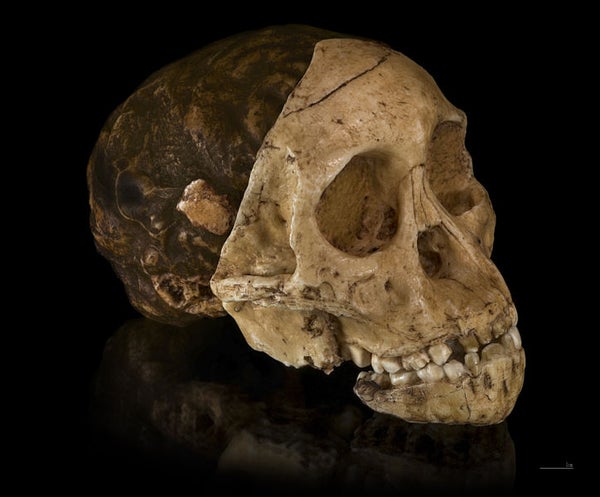This article was published in Scientific American’s former blog network and reflects the views of the author, not necessarily those of Scientific American
I just encountered a synchronicity too striking not to share.
First, I read a New Yorker profile, “Digging for Glory,” by Paige Williams, of paleoanthropologist Lee Berger, a major player in the highly competitive human-origins racket. The New Yorker portrays Berger as a “facile story-teller” who promotes himself and hypes his findings too aggressively.
I was still mulling over the profile, wondering whether it was fair, when I heard Berger talking on Radio Lab about his re-interpretation of the legendary Taung child. (The show, called “The Skull,” aired originally in 2014.) I knew a little about Taung child because it played a role in the history of speculation about the origins of human violence.
On supporting science journalism
If you're enjoying this article, consider supporting our award-winning journalism by subscribing. By purchasing a subscription you are helping to ensure the future of impactful stories about the discoveries and ideas shaping our world today.
Raymond Dart, who discovered Taung child in South Africa in 1925, described it as a 2.5-million-year-old precursor to the Homo lineage. Other anthropologists initially resisted Dart’s claim, because they thought humans originated in Europe. Taung child was eventually accepted as a specimen of Australopithecus africanus, helping establish Africa as humanity’s birthplace.
Dart speculated that the child was killed by another member of its species. Dart’s view of Australopithecines as murderous brutes was one of the inspirations for the famous scene at the beginning of 2001: A Space Odyssey, in which one ape-man clubs another to death with a bone.
Dart’s conjecture about the death of the child—and about the savagery of Australopithecines--was discredited when other anthropologists asserted that the marks on the child’s skull were more likely to have been caused by predator, such as a big cat. (Unfortunately, the deep-roots theory of war persists.)
Back to Berger. During an excavation in South Africa in 1994, he said on Radio Lab, he watched an eagle grab a monkey by the head and fly off with it. Berger tracked down the eagle’s nest and found monkey skulls with puncture marks left by the eagle’s talons.
Over the next dozen years, Berger presented evidence that the marks left by African eagles on the skulls of their prey match marks on the skull of Taung child. The evidence suggests that “the Taung child was itself the victim of a bird of prey,” Berger wrote in 2006.
As Berger a bit too gleefully described, on Radio Lab, the talon scratches inside the eye sockets of Taung child, I had a flashback. About a dozen years ago, I was attacked in woods near my home in the Hudson Highlands. Here’s how I describe the incident in a previous post:
I was jogging on a park trail on a warm spring day, without a care in the world, when something whacked me, hard, in the back of the head. I touched my scalp, and my fingers came away covered with blood.
Angry and alarmed, I scanned the woods for the maniac who had hurled a rock at me. I assumed it was someone I had hounded from the park for illegal hunting or dirt-biking. Then I heard a high-pitched staccato shriek. I glanced up and spotted a large hawk with a white speckled chest and gray back glaring at me from a branch about 25 feet above the trail. A big nest balanced on nearby branches.
I backed down the trail 30 or 40 feet, eyeing the bird, then whirled around and ran home. I recounted the ambush to my wife, Suzie, a wild-bird rehabilitator who specializes in raptors--and who wrote a memoir about her exploits, Flyaway.
Suzie immediately deduced that I had encountered a female goshawk; they are much bigger than males and notoriously aggressive in protecting their young. She commanded me not to run on the path under the goshawk nest for a couple of months, to give the youngsters time to fledge.
So naturally a day or two later I put a bicycle helmet on and climbed a slope near the goshawk nest to check it out. Sure enough, I could see several pale, fluffy babies inside the nest. The mom was there too, glaring at me. (My suspicion is that goshawks glare even when they're in a good mood.) Feeling safe in my helmet, I waved at her, returned to the trail and started jogging home.
Wham! Without any warning she whacked me again. One of her talons poked through my helmet (which was actually old and flimsy) and perforated my scalp; in the same instant she also raked my forehead. I felt lucky that she did not pierce my eyes.
When I went back home, my wife, now ex-wife, looked at my helmet and bloody face and said—and this is a quote from her memoir—"Oh, my God! What did you do to that bird!"
The goshawk didn't want to eat me. She was just protecting her young. But when she attacked me the second time she was, I’m pretty sure, going for my eyes.
Final thoughts: Berger may be a self-promoter, but he has a genuine knack for discovery, and he shares his findings with other researchers in a way that is unusual, and admirable.
And maybe his stories are “facile,” but I liked the ones he told on Radio Lab. I am also intrigued by Berger’s suggestion that the primordial threat of raptor predation may have left its mark on our genes. Many of us, he said, if we’re standing outside and a shadow passes over us, get a “tingly feeling” and instinctively yank our heads skyward.
I do in fact feel tingly and yank my head if I sense something hurtling toward me. But in my case it’s probably nurture more than nature.
Further Reading:
